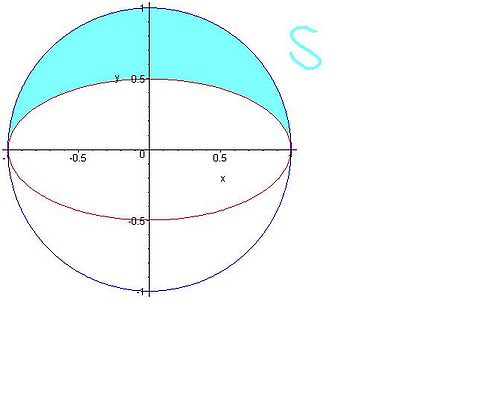Science:Math Exam Resources/Courses/MATH101/April 2008/Question 07 (b)
{{#incat:MER QGQ flag|{{#incat:MER QGH flag|{{#incat:MER QGS flag|}}}}}}
• Q1 (a) • Q1 (b) • Q1 (c) • Q1 (d) • Q1 (e) • Q1 (f) • Q1 (g) • Q2 (a) • Q2 (b) • Q2 (c) • Q2 (d) • Q3 (a) • Q3 (b) • Q3 (c) • Q3 (d) • Q4 (a) • Q4 (b) • Q5 (a) • Q5 (b) • Q6 • Q7 (a) • Q7 (b) •
Question 07 (b) |
|---|
|
Let E be the ellipse x2 + k2y2 = 1, where k is a constant with k ≥ 1. Let S be the region inside the circle x2 + y2 = 1, outside E, and above the x-axis. Find all values of k such that the centroid (centre of mass) of S lies inside S (i.e. outside E). You may use the result of part (a). |
|
Make sure you understand the problem fully: What is the question asking you to do? Are there specific conditions or constraints that you should take note of? How will you know if your answer is correct from your work only? Can you rephrase the question in your own words in a way that makes sense to you? |
|
If you are stuck, check the hint below. Consider it for a while. Does it give you a new idea on how to approach the problem? If so, try it! |
Hint |
|---|
|
The coordinates of the centroid are computed using the formulas and where |
|
Checking a solution serves two purposes: helping you if, after having used the hint, you still are stuck on the problem; or if you have solved the problem and would like to check your work.
|
Solution |
|---|
|
A picture when k is 2 is drawn below. To compute the area of S, we actually don't need to do any more work. Notice that the area of the blue circle when y is greater than 0 is half the area of the unit circle which is . Now, the area of the ellipse when y is greater than 0 is again half the area of the ellipse, which by the previous problem is . Hence, the area of S is
Now, notice that when x is 0, then the two points on the ellipse are . So the one lying in the upper half of the plane is . The question asks when is the centroid outside of E (so inside S). By symmetry, the x coordinate of the centroid is 0. So all we need to do is figure out when (NOTE: There is a bit of ambiguity in the sense that is something on the boundary of S and E inside S or outside of E - I suspect students using greater than or equal to vs just greater than would earn full marks but it is something we should be a bit careful with). In any case, we compute when
Here, the upper curve is the positive half of the circle so
and the lower curve is the upper half of the ellipse so
The picture also clearly shows that we are integrating from (we could have explicitly found these points of intersection as well). Thus, we have
where in the last step we factored out a . Pulling out the terms depending only on k in the integral and using the fact that the integral is the integral of an even function over a symmetric interval yields
Using the inequality derived above, we have
and this completes the proof. |
{{#incat:MER CT flag||
}}


















